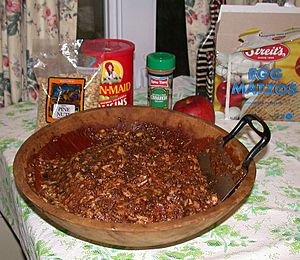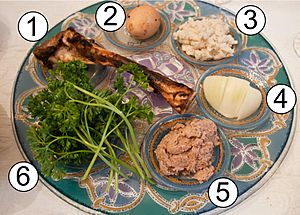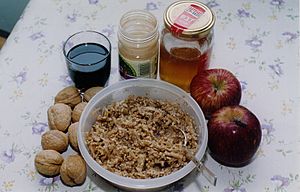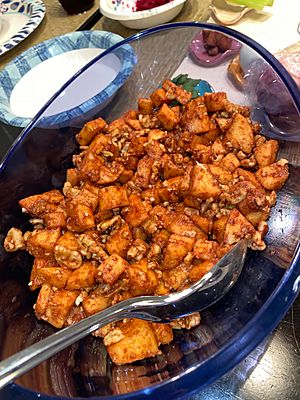Charoset facts for kids
 |
|
| Alternative names | duqqa, dukah, dukeh |
|---|---|
| Course | Sweet relish |
| Place of origin | Land of Israel |
| Region or state | Jewish Diaspora, Ashkenaz, Sepharad, Israel |
| Main ingredients | Apples, Pears, Raisins, Figs, Orange juice, Red wine, Pine nuts and Cinnamon |
| Variations | Dates, Walnuts, Sesame, Wine vinegar, Cinnamon, Black pepper, Marjoram |

1. Zeroa (shankbone)
2. Beitza (roasted hard-boiled egg)
3. Maror/Chazeret (horseradish)
4. Maror/Chazeret (onion)
5. Charoset
6. Karpas (parsley)
Charoset (also spelled haroset or charoises) is a sweet, dark-colored paste. It is made from fruits and nuts. Jewish people eat it during the Passover Seder.
The name charoset comes from the Hebrew word cheres, which means 'clay'. Its color and texture are meant to remind people of the mortar or mud. This was used by the Israelites when they were enslaved in Ancient Egypt. This is mentioned in an ancient Jewish text called the Talmud.
Charoset is one of the special symbolic foods on the Passover Seder Plate. During the Seder, people first dip maror (bitter herbs) into charoset. Then, they make a "Hillel sandwich" with two pieces of matzah (unleavened bread), charoset, and maror. Many people also enjoy eating leftover charoset spread on matzah.
Contents
The Story Behind Charoset
Charoset has a very long history. It is mentioned in the Mishnah, an important Jewish text written long ago. It talks about the foods placed on the Passover table, including "unleavened bread and lettuce and charoset."
Some historians think charoset might be connected to ancient Greek traditions. In those times, people had gatherings called "symposia." During these events, they would discuss philosophy and dip foods into mixtures of pounded nuts and spices.
Different Styles of Charoset
There are many different ways to make charoset. Recipes often include fruits and spices mentioned in the Song of Songs. These can be apples, figs, pomegranates, grapes, walnuts, and dates. Wine, saffron, and cinnamon are also common additions.
The spices used can change depending on where Jewish communities live. For example, people from Yemen often use cloves and pepper. American Jews usually add cinnamon. In Italy, some Jewish communities add chestnuts and pine nuts. Halek is a special kind of charoset made by Persian Jews using dates instead of apples. In Maine, some people even add local blueberries!
Sephardi Traditions
Sephardi Jews are Jewish people whose families came from Spain, Portugal, North Africa, and the Middle East. Their charoset is often a paste made from raisins, figs, and dates.
- Egyptian Jews make it with dates, raisins, walnuts, cinnamon, and sweet wine.
- Greek and Turkish Jews use apples, dates, chopped almonds, and wine.
- Italian Jews sometimes add chestnuts to their recipes.
- Suriname Jews might include coconut.
- Iraqi Jews make it from a mix of dates and nuts.
Yemenite Tradition
In Yemenite Jewish tradition, charoset is also called dukeh. It is made by pounding figs, raisins, or dates into a dough-like paste. Then, vinegar and spices are added. Some people also put ground sesame seeds in it.
On the night of Passover, whole spices are added. These might be valerian, marjoram, or savory. This makes the mixture look like straw in mortar. It helps people remember how their ancestors were enslaved in Egypt, building with bricks and straw.
Mizrahi Traditions
Mizrahi Jews are Jewish people from the Middle East and North Africa. Some of them use the term "halegh" instead of charoset. The exact origin of halegh is not fully clear.
In Iran, some Jewish communities have a tradition of including 40 different ingredients in their halegh. The number 40 is symbolic. It represents the 40 years the Israelites wandered in the desert after leaving Egypt.
Ashkenazi Traditions
Ashkenazi Jews are Jewish people whose families came from Eastern Europe. Their charoset is usually made from chopped walnuts and apples. It is spiced with cinnamon and sweet red wine. Sometimes, Honey or sugar is added to make it sweeter and help it stick together. This mixture is usually not cooked.
Modern Twists
In 2015, Ben & Jerry's ice cream even created a Charoset ice cream! It became very popular in Israel and was featured in many news stories.
What to Do with Leftovers
If you have charoset left over, it's often eaten with more matzah. It can also be used as a sweet filling for small hand pies. Another popular use is as a filling for hamantaschen, which are special triangular cookies.
See also
 In Spanish: Jaroset para niños
In Spanish: Jaroset para niños



